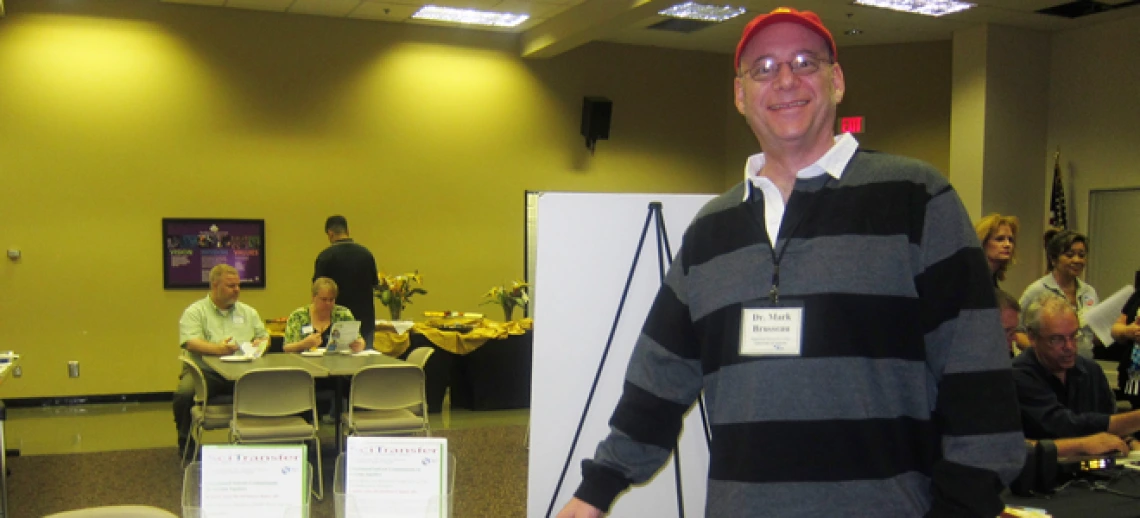Brusseau at the Cutting-Edge of Research Translation

 Dr. Mark Brusseau, University of Arizona Superfund Research Program (UA SRP) investigator and Research Translation Core leader, has long been at the forefront of research translation, delivering chlorinated solvent science to stakeholders since 1993. Such activities are now a required component of every National Institute of Environmental Health Sciences-funded Superfund Research Program.
Dr. Mark Brusseau, University of Arizona Superfund Research Program (UA SRP) investigator and Research Translation Core leader, has long been at the forefront of research translation, delivering chlorinated solvent science to stakeholders since 1993. Such activities are now a required component of every National Institute of Environmental Health Sciences-funded Superfund Research Program.
Brusseau actively practices research translation at a number of Arizona Superfund sites. Last July 24, 2013, Brusseau and his research team visited the Motorola, Inc. (52nd Street Plant) Superfund site with US Environmental Protection Agency (US EPA) and remediation consultants in order to collect samples for a phytoscreening project. Later that evening, he and the UA SRP team attended the Motorola Community Information Group meeting, where affected community members, responsible parties, and remediation coordinators come together to discuss site issues. On January 16, 2014, Brusseau participated in the Tucson International Airport Area (TIAA) Superfund site annual Technical Meeting that brings together consultants and researchers involved in remedial investigations at the site. Brusseau presented his work on subsurface contaminant transport mechanisms of chlorinated solvents.
 According to Brusseau, “attending this meeting each year greatly helps me to maintain my contacts and partnership building.” On February 5, 2014, Brusseau interacted with US EPA remedial project managers and consultants for the Phoenix-Goodyear Airport Superfund site to discuss remediation plans for the site. Later that day, he attended the US EPA Proposed Plan Open House and Public Meeting, where community members could comment on proposed additions to the site’s clean-up plan. The US EPA requested Brusseau’s presence due to his long-standing status as an expert on chlorinated solvent issues. On April 9, 2014, Brusseau was invited by US EPA to attend the Hassayampa Landfill Superfund site Technical Meeting to discuss potential collaborative efforts related to their remedial action plan.
According to Brusseau, “attending this meeting each year greatly helps me to maintain my contacts and partnership building.” On February 5, 2014, Brusseau interacted with US EPA remedial project managers and consultants for the Phoenix-Goodyear Airport Superfund site to discuss remediation plans for the site. Later that day, he attended the US EPA Proposed Plan Open House and Public Meeting, where community members could comment on proposed additions to the site’s clean-up plan. The US EPA requested Brusseau’s presence due to his long-standing status as an expert on chlorinated solvent issues. On April 9, 2014, Brusseau was invited by US EPA to attend the Hassayampa Landfill Superfund site Technical Meeting to discuss potential collaborative efforts related to their remedial action plan.
Dr. Brusseau’s extensive experience at Arizona Superfund sites impacted by chlorinated solvent groundwater contamination is allowing him to complete a comparative study of the effectiveness of remediation strategies being used at the various sites (stay tuned for a publication later this year!) True to the ideals of research translation, Brusseau has already presented the initial findings of his study to stakeholders including community members, consultants, and state and federal remedial project managers. He participated in the SRP-EPA “Live at Region 9” seminar series in December, and reprised his talk via CLU-IN webinar for an international audience of 624 participants.
Describing his motivation for maintaining active relationships with stakeholders, Brusseau explains, “Implementing research translation as an integral element of our research helps ensure that our efforts have real-world impacts, and it keeps our program attuned to the critical issues in environmental and human-health science.” Keep up the great work, Mark!

